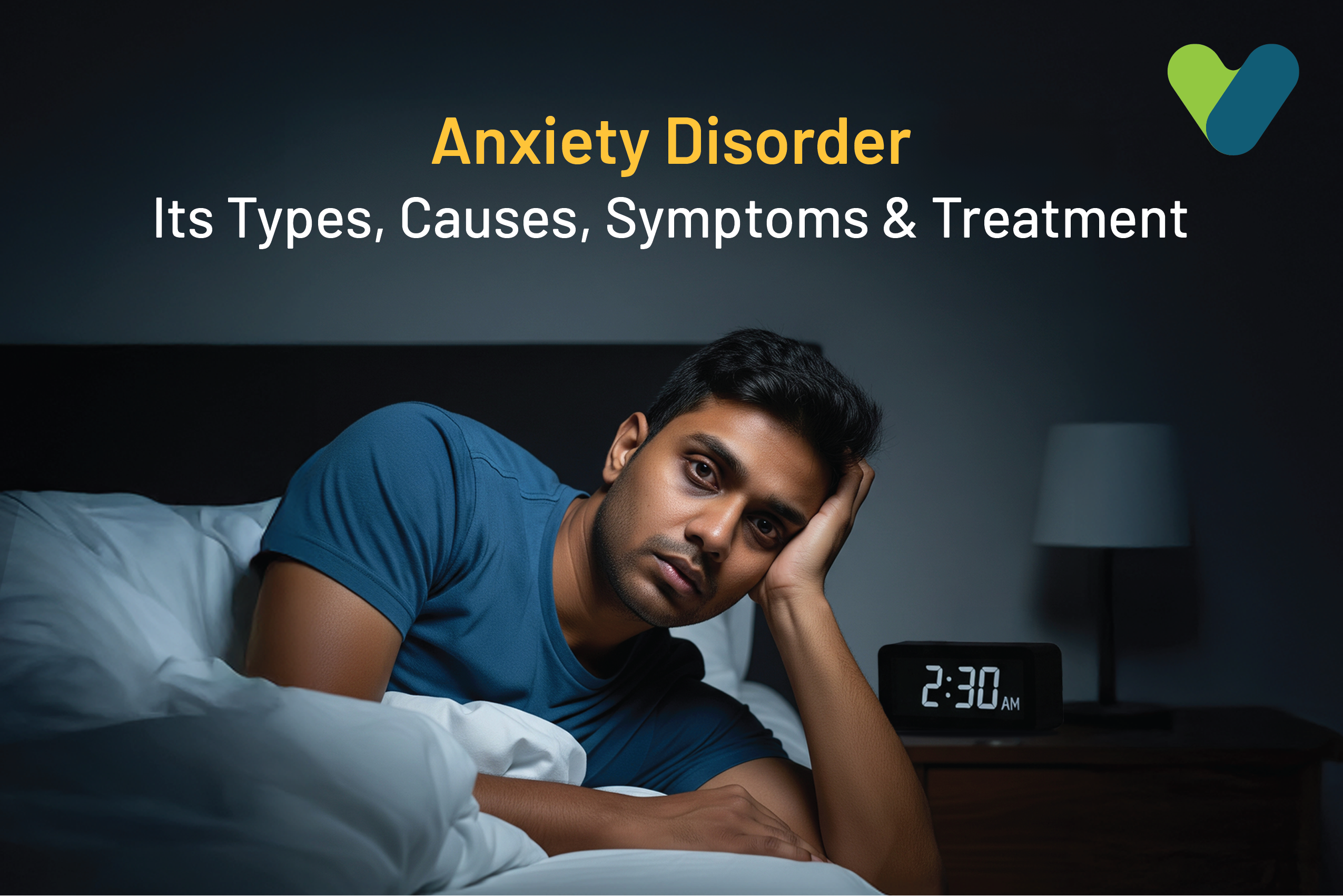Anxiety is the universal emotional reaction to a threat or stress perception. It is how the body compensates itself in anticipation of some kind of task to perform (whether it is a speech to be made, an examination to be gathered, or a sudden uncomfortable situation).
Anxiety may become beneficial in these situations as it helps make people more alert and improves their work. But when anxiety continues even after the situation or when there is no apparent cause of the anxiety, then it may become very worrying and disabling. This is when it morphs into a mental condition called an anxiety disorder.
Anxiety disorders are one of the most widely spread mental disorders nowadays, with millions of people being affected annually. They can interfere with daily life, damage relations, and the capacity of an individual to operate in the place of work or socializations. The silver lining is, anxiety disorders are manageable and can be solved through the appropriate care, support and intervention in time.
In this article, we will discuss what anxiety disorders are, the causes of anxiety disorder symptoms of anxiety disorders, anxiety disorders types, the diagnosis, the treatment of anxiety disorders, and also lifestyle measures to manage anxiety.
What Are Anxiety Disorders?
Anxiety disorders refer to a set of mental disorders that are associated with extreme fearfulness, anxiety, and behavioural disorders. Such emotions are usually enduring, unreasonable, and hinder the normal performance of an individual.Contrary to the usual stress, anxiety disorders do not go away over time or after assurance. They tend to worsen, resulting in avoidance behaviours, emotional breakouts, and social barriers.
Anxiety disorder patients are aware that their fears are excessive, but they are unable to do anything about them. These maladies may also fluctuate between slight uneasiness and extreme, incapacitating fear, interfering with the capability of a person to work, attend school or have relationships.
Anxiety disorders are the most common mental disorders in the world, and it is estimated that the number of people with anxiety disorders is 301 million, as per the World Health Organisation. It is important to comprehend the definition of these disorders along with their differences from normal feelings of anxiety so that they can be identified and treated properly.
Other forms of anxiety are generalised anxiety disorder, social anxiety disorder, panic disorder, and phobias, among others. Although these manifest themselves in different ways, they remain together in the category of anxiety disorders since they share the element of excessive fear or anxiety.
Causes of Anxiety Disorders
Identification of the causes of anxiety disorders is going to play a crucial role in early detection and prevention. One does not have only one reason to be afflicted with an anxiety disorder. Instead, it tends to be a genetic, environmental, psychological and physiological aggregate.1. Genetics and Family History
- People with a family history of anxiety or other mood disorders are more likely to develop anxiety disorders themselves.
- Genetic factors may influence how the brain responds to stress and fear, making some individuals more susceptible.
2. Brain Chemistry and Neurological Factors
- Neurotransmitters like serotonin, dopamine, and norepinephrine play a major role in regulating mood and emotions.
- Imbalances in these chemicals can alter how the brain processes anxiety and stress.
- Structural differences in areas such as the amygdala, which processes fear, may also be linked to anxiety disorders.
3. Personality and Behavioural Traits
- Individuals with low self-esteem, perfectionistic tendencies, or those who are highly sensitive to criticism are more prone to developing anxiety.
- People who avoid situations that make them anxious may reinforce a pattern of fear and withdrawal, which increases the risk.
4. Life Experiences and Trauma
- Traumatic experiences, such as abuse, the death of a loved one, or surviving a natural disaster, can trigger anxiety disorders.
- Chronic stress at work, academic pressure, or long-term illness can also contribute.
5. Medical Conditions
- Certain health issues like heart disease, diabetes, hyperthyroidism, or respiratory disorders may mimic or trigger anxiety symptoms.
- Hormonal imbalances (especially in women during menopause or pregnancy) may also play a role.
6. Substance Use
- Alcohol, caffeine, and drug use can both trigger and worsen anxiety symptoms.
- Withdrawal from certain substances, like benzodiazepines or stimulants, can induce high levels of anxiety.
Symptoms of Anxiety Disorders
The symptoms of anxiety disorders can be broad and affect emotional, physical, and cognitive functioning. These symptoms often occur in patterns and may be triggered by specific situations or come unexpectedly.Emotional Symptoms:
- Persistent fear, dread, or nervousness without an identifiable cause.
- Irritability or mood swings.
- A constant feeling of being “on edge” or unable to relax.
Cognitive Symptoms:
- Racing thoughts or an inability to stop worrying.
- Poor concentration or memory lapses.
- Catastrophic thinking—expecting the worst-case scenario in every situation.
Physical Symptoms:
- Rapid heart rate, palpitations, and chest pain.
- Shaking, trembling, or muscle tension.
- Shortness of breath or hyperventilation.
- Sweating, cold hands or feet.
- Upset stomach, nausea, diarrhoea, or gastrointestinal distress.
- Dizziness or feeling faint.
- Trouble falling or staying asleep.
Types of Anxiety Disorders
There are several types of anxiety disorders, each with specific characteristics, triggers, and treatment approaches. Understanding the distinctions between these different anxiety disorders allows for more effective management.1. Generalized Anxiety Disorder (GAD)
- People with GAD experience excessive and uncontrollable worry about everyday situations such as health, finances, or family issues.
- The worry is often unrealistic and not proportional to the actual situation.
- It must persist for at least six months to be diagnosed.
- Physical symptoms often include fatigue, muscle tension, and trouble sleeping.
2. Panic Disorder
- Involves recurrent, unexpected panic attacks—sudden episodes of intense fear accompanied by physical symptoms.
- Individuals may feel like they’re having a heart attack or dying.
- Panic attacks can last from a few minutes to over an hour and often occur without warning.
- People may begin to fear having future attacks, leading to avoidance behaviours.
3. Social Anxiety Disorder
- Also called social phobia, this disorder involves intense fear of being judged or embarrassed in social or performance situations.
- Common triggers include speaking in public, eating in front of others, or attending social gatherings.
- People may avoid these situations altogether, leading to isolation and loneliness.
4. Specific Phobias
- Characterized by an irrational fear of a specific object or situation, such as heights, animals, or blood.
- The fear is immediate and intense, often leading to avoidance.
- Exposure may trigger panic-like symptoms.
5. Agoraphobia
- Fear of being in situations where escape might be difficult, such as in crowds, elevators, or open spaces.
- Often develops alongside panic disorder.
- Some people with agoraphobia may become housebound.
6. Separation Anxiety Disorder
- Commonly associated with children, but it can affect adults.
- Involves extreme fear of being apart from loved ones.
- Symptoms include nightmares, physical complaints, and reluctance to go to school or work.
Diagnosis of Anxiety Disorders
Diagnosing anxiety disorders involves a careful and systematic evaluation by a qualified mental health professional. Since symptoms can resemble those of other conditions, an accurate diagnosis is critical.Evaluation Process:
- Initial Screening
- Health professionals begin by asking questions about the patient's medical history, emotional well-being, and lifestyle habits.
- Psychological Assessment
- Questionnaires and diagnostic tools like the GAD-7, Beck Anxiety Inventory (BAI), and others are used to measure symptom severity.
- Medical Testing
- Physical exams and lab tests may be ordered to rule out medical conditions like thyroid problems or heart arrhythmias.
- DSM-5 Criteria
- Diagnoses are based on the Diagnostic and Statistical Manual of Mental Disorders (DSM-5), which lists criteria for each type of anxiety disorder.
Treatment Options for Anxiety Disorders
Effective treatment of anxiety disorders often involves a combination of therapies tailored to individual needs. Early intervention and consistency are key.1. Psychotherapy (Talk Therapy)
- Cognitive Behavioural Therapy (CBT): Helps individuals identify, understand, and modify negative thought patterns.
- Exposure Therapy: Gradual exposure to feared stimuli helps desensitise individuals.
- Dialectical Behaviour Therapy (DBT): Useful for people with severe emotional regulation issues.
- EMDR (Eye Movement Desensitisation and Reprocessing): Especially effective for trauma-related anxiety.
2. Medications
- SSRIs (Selective Serotonin Reuptake Inhibitors): First-line drugs
- SNRIs (Serotonin-Norepinephrine Reuptake Inhibitors): Effective in cases resistant to SSRIs.
- Benzodiazepines: Short-term relief for acute anxiety; risk of dependence.
3. Complementary and Alternative Therapies
- Mindfulness-Based Stress Reduction (MBSR)
- Acupuncture
- Biofeedback
- Nutritional Therapy focusing on omega-3s, magnesium, and B vitamins.
4. Support Groups and Community Resources
- Offer emotional support and practical advice.
- Encourage open discussion in a stigma-free environment.
Managing Anxiety in Daily Life
While professional care is essential, self-care strategies play a huge role in long-term management. Daily habits can strengthen resilience and prevent relapse.Self-Help Tips:
- Practice Breathing Exercises: Deep breathing calms the nervous system.
- Keep a Journal: Writing about fears can help process emotions.
- Limit Caffeine and Alcohol: Both can exacerbate anxiety symptoms.
- Set Realistic Goals: Break tasks into small steps to avoid overwhelm.
- Establish Routine: Predictable schedules reduce uncertainty.
- Build Social Connections: Stay in touch with friends or family.
Conclusion
Anxiety disorders belong to quite complicated but highly treatable mental conditions. These disorders can happen to any person at any age of life since they are caused by genetics, life experience, or brain chemistry. It is extremely important to be able to recognise the symptoms, to know the types of anxiety disorders, and to understand the causes of anxiety disorders as a significant means of curing.When combined with therapy and medication, lifestyle changes and support, individuals with anxiety disorders can enjoy productive lives. Whether you are affected or someone you love is, you can help; since recovery, help, and serenity are possible.


